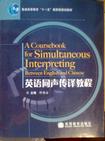英语同声传译教程
出版时间:2008-9 出版社:高等教育 作者:仲伟合 页数:377
Tag标签:无
内容概要
《英语同声传译教程》以同声传译技能为主线安排教程的框架,突出强调同声传译训练的技能性原则;以口译专题(如经贸合作、知识产权、文化交流、科技创新等)来安排练习的内容,突出强调同声传译的实践性原则;以全真会议录音为训练材料,突出强调同声传译训练的真实性原则。
作者简介
仲伟合,广东外语外贸大学副校长、博士、教授、翻译学博士生导师。曾先后留学英国、美国。目前兼任国务院学位委员会“全国翻译硕士专业学位教育指导委员会”副主任委员、教育部高校外语专业教学指导委员会委员、全国翻译专业资格(水平)考试英语专家委员会委员、中国翻译工作者协会常务理事、专家会员、广东省翻译协会副会长、广州翻译协会、广州科技翻译协会副理事长、广州外事翻译协会副会长等。国家级精品课程“英语口译(课程系列)”主持人、广东省高等教育教学名师、广东省杰出留学归国青年创业之星、全国优秀教师及广东省青年“五四”奖章获得者。曾为多位国家、省市领导人及外国国家元首、政商耍人等担任口译工作,从上个世纪90年代开始,已担任数百场国际会议的同声传译工作。已主编出版国家级规划专业口译教材两部、其他著作、辞典等多部,在《中国翻译》等学术期刊发表论文50余篇,承担多项省部级科研项目。
书籍目录
影子练习:国际关系主题Topic for Interpreting:International Relations第一单元 同声传译概论Unit One Introduction to SimuLtaneous Interpreting第一部分 技能篇1.同声传译的概念2.同声传译的发展历史3.同声传译的工作程序4.同声传译译员素养要求第二部分 练习篇Exercise OneExercise TwoExercise Three记忆复述练习:和平与发展主题Topic for Interpreting:Peace and Development第二单元 同声传译记忆Unit Two Memory in Simultaneous Interpreting第一部分 技能篇1.源语单语连续复述2.源语单语同声复述3.源语单语延迟复述第二部分 练习篇:记忆复述练习Exercise OneExercise Two目标语复述练习:外交事务主题Topic for Interpreting:Foreign Affairs第三单元 同声传译中的注意力分配Unit Three Split of Attentionin Simultaneous Interpreting第一部分 技能篇1.理论概述2.技能指导第二部分 练习篇:目的语复述练习Exercise OneExercise Two视译练习:世贸组织主题Topic for Interpreting:WTO(World Trade Organization)第四单元 视译Unit Four Sight Interpreting第一部分 技能篇1.何为视译?2.如何对视译进行准备工作?3.如何练习视译?第二部分 练习篇:视译练习Exercise OneEXercise Two深度视译练习:中国经济主题Topic for Interpreting:Chinas Economy第五单元 同声传译基本原则Unit Five Principles of Simultaneous Interpreting……同传技巧练习:商务合作主题Topic for Interpreting:Business Cooperation第六单元 同声传译技巧(1)Unit Six Simultaneous Interpreting Skills(Ⅰ)同传技巧练习:全球竞争与合作主题Topic for Interpreting:Global Competition and Cooperation第七单元 同声传译技巧(2)Unit Seven Simultaneous Interpreting Skills(Ⅱ)应对策略练习:旅游与酒店业主题Topic for Interpreting:Tourism and Hotelling第八单元 同声传译应对策略Unit Eight Coping Tactics in imultaneous Interpreting金科玉律练习:物流产业主题Topic for Interpreting:Logistics第九单元 同声传译金科玉律Unit Nine The Golden Rules of Simultaneous Interpreting同传实战演练:体育活动主题Topic for Interpreting:Sports第十单元 同声传译设备Unit Ten Simultaneous Interpreting Facilities同传实战演练:教育发展主题Topic for Interpreting:Education第十一单元 同传译员的工作条件与职业操守Unit Eleven Code of Conducts for Simultaneous Interpreting译前准备练习:科技创新主题Topic for Interpreting:Sci-tech Innovation第十二单元 同声传译的译前准备工作Unit Twelve Preparation for Simultaneous Interpreting模拟会议练习:产业升级主题Topic for Interpreting:Industrial Upgrading第十三单元 国际会议Unit Thirteen Introduction to International Conferences模拟会议练习:常见会议主题Topic for Interpreting:Popular Conference Topics第十四单元 常见会议主题Unit Fourteen Introduction to Popular Conference Topics第十五单元 复习与测试Unit Fifteen Revision and Model Tests附录
章节摘录
Before I conclude, let me tel! you a little secret. And I learnt this secret in visiting thelibrary of the WTO. There is in this library an apocryphal and funny Secretariat guide to thelanguage of trade negotiators in the old GATT. Now this guide tells you that, in those years,when negotiators said "Mr Chairman, we seek a balanced agreement", what they really meantwas "this agreement had better contain everything we demand"; when the negotiators saidin those times "we have demonstrated flexibility", they really meant "we have successfullyconcealed our intransigence"; and when the negotiators announced "we are prepared to makeour contribution to an ambitious outcome", they really meant "we will only support agreementswhere others make all the concessions, and we make none"! This attitude, as we all very wellknow, is part of our past. This is the past because today, what we really need are negotiators that are bold, open-minded and prepared to take some risks, as successful shareholders and stakeholders do it.Ministers, we all know that, often face the difficult task of explaining to national constituenciesthat they gain something in negotiations, even if the negotiating process is not over. The manypeople who benefit from open trade are usually politically silent, whereas those fewer whoare affected by opening trade are politically much louder. So we all understand the need ofeach and every delegation to take home some gain from trade negotiations to rebalance thisasymmetry between winners and losers. The reality is that the true magic of these negotiations is to achieve results where allparticipants are winners, all will be able to declare victory. But for that, some risks have tobe taken. A popular Chinese proverb says "If you dont go into the cave of the tiger, how willyou get its cub?" —— in other words: nothing ventured, nothing gained.
编辑推荐
《英语同声传译教程》将口译技能与口译专题有机地结合在一起,按专业译员应该掌握的同传技能的先后顺序安排教程的框架,同时每—个单元紧扣一个专题,使学习者在掌握口译基本技能的同时,了解专题口译应该掌握的知识、术语等。
图书封面
图书标签Tags
无
评论、评分、阅读与下载
